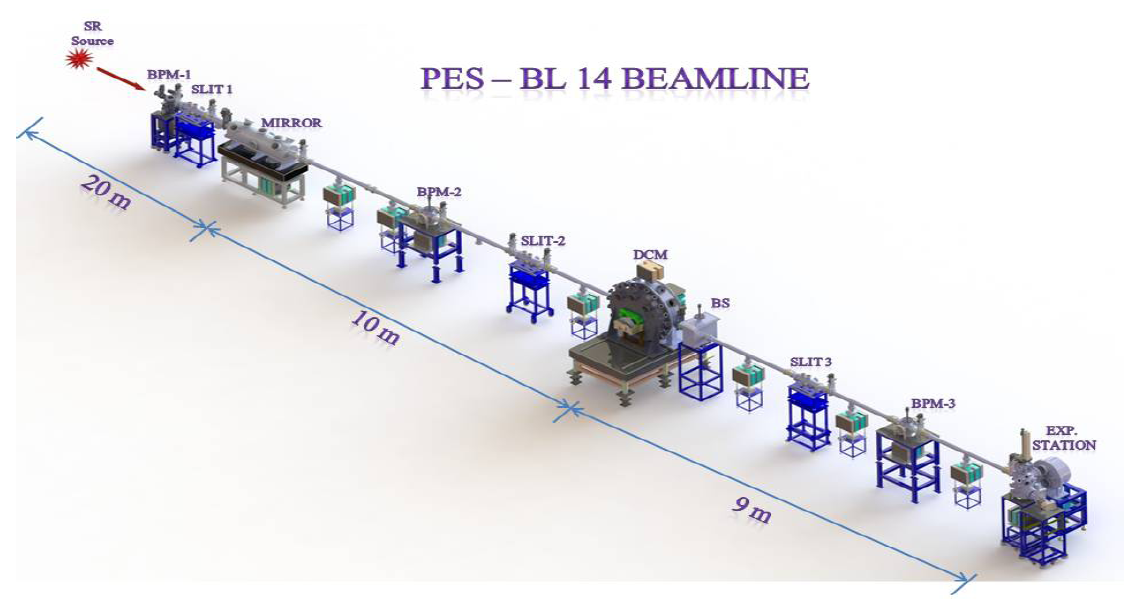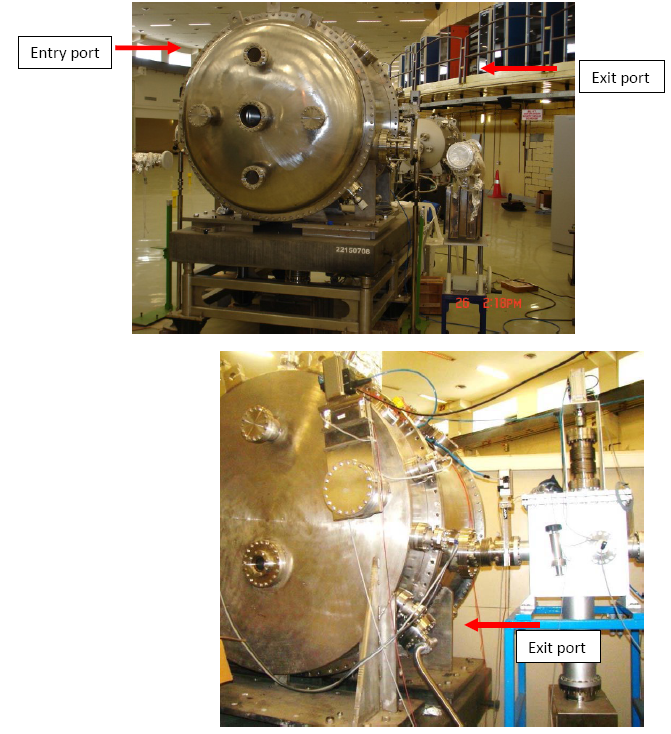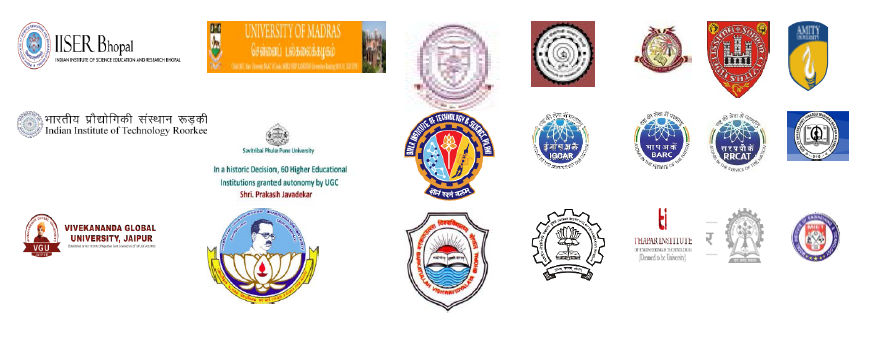X-ray Photo-Electron Spectroscopy Beamline (BL-14)
Introduction:
The X-ray Photo-Electron Spectroscopy (PES) beamline is devoted to the high-resolution photoelectron spectroscopy of solids in the hard X-ray region The beamline is installed at 1.5 T bending magnet source of Indus-2. The most of the components of the beamline are indigenously designed and developed and the beamline covers an energy range from 2 keV to 15 keV. It facilitates the powerful technique of XPS to probe the elemental composition, chemical states and electronic states of elements in near surface region of both thin films and bulk materials. In this technique, a material is bombarded by high energy X-rays from synchrotron and an energy spectrum of emitted photo-electrons is analysed. The spectrum is used to calculate binding energy of electrons in the material which in turn provides information of elements present on the surface and their bonding with other elements. Conventional lab based PES provides information of the materials up to a depth of about 1 nm from the surface due to small mean free path of emitted electrons. The high energy X-ray would provide information at larger depths ( ̴10 nm) due to increase in the mean free path with electron energy.
Beamline Specifications:
| Source
|
Bending magnet (1.5 T) |
| Length of the beamline
|
39 metres from the tangent point |
| Energy Range
|
2-15 keV |
| Acceptance
|
0.4 mrad (V) X 3.0 (H) |
| Pre-Mirror
1.1 m long Pt-coated horizontal toroid shape mirror
|
|
| Monochromator |
Double Crystal Monochromator (DCM) using pair of Si (111) crystals |
| Spot size @sample |
1.0 mm (H) x 2.0 mm (V) |
| Detector |
Phoibos 225 hemispherical analyzer with MCP detector |
| Photon flux [ph/s] |
1010 |

3D View of PES-14 beamline

Optical Layout of the beamline

Optical hutch part-1 (toroidal pre-mirror chamber, BPM and slit)

In-house developed Double Crystal Monochromator and beam stopper
Experimental Station:
The experimental station consists of an ultra-high vacuum compatible chamber in which various probes, Specs Make Phoibos 225 hemispherical analyser (HSA), detectors and other facilities are housed.It is made of stainless steel with suitable ports to let the synchrotron radiation in and designed to reach a base pressure ≤ 5x10-9 mbar to provide clean conditions for sample analysis. A high energy (up to 15 keV) HSA capable to provide energy resolution ~ 10-4 has been designed and fabricated. For detection of high energy photo electrons from HSA, a high resolution 2D imaging system has been implemented using a MCP (Micro-channel Plate) with phosphor and CCD. A fluid gun which is highly recommended for XPS of insulating samples is also mounted in the experimental station. An argon ion itching gun is also the part of the experimental station which is benefitting in doing layer by layer XPS of samples.

Experimental station of PES beamline
Publications
2018
-
HAXPES beamline PES-BL14 at the Indus-2 synchrotron radiation source, Jagannath, U. K. Goutam, R. K. Sharma, J. Singh, K. Dutta, U. S. Sule, R. Pradeep and S. C. Gadkari, J. Synchrotron Rad. (2018)25, 1541–1547.
- Facile synthesis of NiSnO3/graphene nanocomposite for high-performance electrode towards asymmetric supercapacitor device, P. E. Saranya and S. Selladurai Journal of Materials Science (2018)53, 16022–16046.
- Grain boundary-dominated electrical conduction and anomalous optical-phonon behaviour near the Neel temperature inYFeO3 ceramics, Subhajit Raut, P. D Babu, R. K. Sharma, Ranjit Pattanayak , and Simanchalo Panigrahi, J. Appl. Phys. (2018)123, 174101.
- Solvent free solid-state synthesis of Pr6O11/g-C3N4 visible light active photocatalyst for degradation of AV7 dye, Ashok G. Shende, SachinG. Ghugal, Devthade Vidyasagar, Sanjay B. Kokane, Jagannath, Suresh S. Umare, Rajamma Sasikala, Materials Research Bulletin, (2018)107, 154–163.
- Tunable blue-green emission from ZnS(Ag) nanostructures grown by hydrothermal synthesis, Manjula Sharma, Shashwati Sen, Jagannath, M. Ghosh, and S. Pitale,Vinay Gupta, S.C. Gadkari, J. Mater. Res., (2018) 33, No. 23, 3963-3970.
- Carbon Nanotube Functionalization and Radiation Induced Enhancements in the Sensitivity of Standalone Chemiresistors for Sensing Volatile Organic Compounds, Mondal, R. K. Dubey, Jitendra kumar, Jagannath, Bhardwaj, Yateindra Kumar, Melo, Jose, Varshney, Lalit, ACS Appl. Nano Mater,(2018)1,10,5470-5482.
- Microflowers of Pd doped ZnS for visible light photocatalytic and photo electrochemical applications, A.P. Gaikwad, C.A. Betty, Jagannath, Asheesh Kumar, R. Sasikala, Journal of Materials Science in Semiconductor Processing (2018)86, 139–145.
2019
- Thin films deposited on silicon and gold surfaces, Jaspreet Singh, R.K. Sharma, UK Goutam, US Sule, Jagannath Gupta, SC Gadkari, Matter. Res. Express 6 (2019)016411.
- Vertically aligned zinc oxide nanosheet for high-performance photocatalysis of water pollutants, Abesh Banerjee, Sayan Chattyopadhyay, Avirup Kundu, Rajendra K. Sharma, Pralay Maiti, Santanu Das, Journal of Ceramics International (2019)45, 14, 16821 – 16828.
- In Situ Green Synthesis andFunctionalization of Reduced Graphene Oxide on Cellulose Fibers by Cannabis sativa L. Extract, Charu Agarwal, M. N. Singh, R. K. Sharma, Archna Sagdeo and Levente Cs´oka, Materials Performance and Characterization (2019) 8(3), 20180149.
- Evaluation of interfacial structure of [111] and [001] oriented epitaxial NiO layers on GaAs substrate by non-destructive techniques, S.D. Singh,,Arijeet Das, M.K. Swami, U.K. Goutam, R.K. Sharma, H.S. Patel, S.K. Rai, Tapas Ganguli, Vacuum 159 (2019) 335–340.
- Depth-resolved compositional analysis of W/B 4 C multilayers using resonant soft X-ray reflectivity, P. N. Rao, U. K. Goutam, Prabhat Kumar, Mukul Gupta Tapas Ganguli and S. K. Rai, J. Synchrotron Rad. (2019) 26, 793–800.
- Hydrothermal synthesis and electrochemical performance of nanostructured cobalt free La2CuMnO6, Jashandeep Singh, Uttam kumar Goutam, Ashok Kumar, Solid State Sciences 95 (2019) 105927.
- A 3D Mesoporous flowers of Nickel Carbonate Hydroxide Hydrate for High-Performance Electrochemical Energy Storage Application Prateek Bhojane, Lichchhavi Sinha, Uttam K. Goutam and Parasharam M. Shirage Electrochimica Acta (2019) 296, 112-119.
- Orientation study of iron Phthalocyanine (FePc) thin films deposited on silicon and gold surfaces Jaspreet Singh, R K Sharma, U K Goutam, U S Sule, Jagannath Gupta, S C Gadkari, P N Rao Mater. Res. Expres (2019)6, 016411.
- Substitution induced magnetic phase transitions and related electrical conduction mechanisms in LaFeO3 nanoparticle T. Lakshmana Rao, M. K. Pradhan, U. K. Goutam, V. Siruguri, V. R. Reddy and S. Dash J Appl. Phys. (2019) 126, 064104.
- Enhancement of Oxidation Resistance of Modified P91 Grade Ferritic-Martensitic Steel by Surface Modification using Laser Shock Peening Arun Kumar Rai, RamakantaBiswal, Ram Kishor Gupta, Sanjay Kumar Rai, Rashmi Singh, Uttam Kumar Goutam, K. Ranganathan, P. Ganesh, Rakesh Kaul and Kushvinder Singh Bindra, Appl. Surf. Sci.(2019)495, 143611.
- Rigid-band electronic structure of scandium nitride across the n-type and p-type carrier transition regime Sanjay Nayak, MadhusmitaBaral, Mukul Gupta, Jaspreet Singh, Magnus Garbrecht, Tapas Ganguli, S M Shivaprasad and Bivas Saha Physical Review B(2019)99, 161117.
- Exploring Burstein-Moss Effect in Nickel Doped Hematite Dendrite Nanostructures for Enhanced Photo-electrochemical Water Splitting Soniya Gahlawat, P Ingole, Jaspreet Singh and Ashoke Yadav, Phys. Chem. Chem. Phys., (2019)21, 20463-20477.
2020
- Existence of Exchange bias and Griffith Phase in (Tb1-xCex)MnO3, Surajit Ghosh, Abhishek Kumar, Arkadeb Pal, Prajyoti Singh, Prince Kumar Gupta, Khyati Anand, U. K. Gautam, A. K. Ghosh and Sandip Chatterjee; J. Magn Magn Mater (2020)500 166261.
- X‐ray reflectivity and X‐ray photoelectron spectroscopy studies on reactively sputtered Nb2O5‐based thin‐film devices, Karimul Islam, Rezwana Sultana, Abhishek Rakshit, U. K. Goutam, Supratic Chakraborty, SN Applied Sciences (2020) 2:782.
- Probing structural and photophysical features of Eu3+ activated NaCdPO4 orthophosphate phosphor, M. K. Pradhan, T. Lakshmana Rao, U. K. Goutam and S. Dash; Journal of Spectrochim. ActaA Mol. Biomol. Spectrosc. (2020) 240 118593
- Mesoporous spheres of Dy2NiMnO6 synthesized via hydrothermal route for structural, morphological, and electrochemical investigation, Jashandeep Singh, Irina Rogge, Uttam Kumar Goutam and Ashok Kumar; Ionics, 2020.https://doi.org/10.1007/s11581-020-03644-z
- Structural, Optoelectronic, and Electrochemical Properties of Zn1–x(Ga0.5Al0.5)xO Nanoparticles for Supercapacitor Applications, S ayaz, P Kumar Mishra, R K Sharma, S Kamal, and S Sen, ACS Appl. Nano Mater(2020)3, 5, 4562–4573.
- Tunable luminescence of Eu3+-activated CaWO4 nanophosphors via Bi3+ incorporation, P Nayak, S S Nanda, R K Sharma, S Dash, Luminescence (2020) 1–9.
- Effect of AFM and FM exchange interaction on magnetic anisotropy properties of single domain SmFeO3 at nanoscale, A A Khan, A Ahlawat, P Deshmukh, RK Sharma, V Srihari, R Singh, R Vaish, AK Karnal, S. Satapathy, Journal of Magnetism and Magnetic Materials (2020)502, 166505.
- ” Synchrotron-based X-Ray analysis: Relating Compressive Lattice Strain with the Photo luminescence Intensity of Li+ Doped NaYF4:Yb3+/Ln3+ (Ln3+=Ho3+/Er3+/Tm3+) Up conversion Crystals", Preeti Verma, D Sarkar, P Rajput, M N Singh, Rajendra Sharma and S Giri; Cryst. Growth Des. (2020)20,1,468–478
- Plasmonic effect of diffused Ag nanoparticles in EB evaporated Ag/TiO2 bilayer thin films and role of oxygen pressure, S M Haque, Rajnarayan De; S Tripathi; R K Sharma; S. R. Polaki; K. D Rao Journal of Alloys and Compounds (2020) 849, 156553.
- Effect of cobalt-doping on dielectric, magnetic and optical properties of BiFeO3 nanocrystals synthesized by sol – gel technique, A. K. Sinha, B. Bhushan, Jagannath, Nidhi Gupta, S. Sen, C. L. Prajapat, J. Nuwad, P. Bhatt, S. K. Mishra, S. S. Meena, A. Priyam, Solid State Sciences (2020) 102, 2020, 106168.
- Electrochemical reduction of CO2 to ethylene on Cu/CuxO-GO composites in Aqueous Solution; Nusrat Rashid, Mohsin Ahmad Bhat, U K Goutam and Pravin Popinand Ingole; RSC Adv. (2020)10, 17572.
- Microstructure and electrochemical performance of La2ZnMnO6 nanoflakes synthesized by facile hydrothermal route, Jashandeep Singh, Amit Kumar, Uttam Kumar Goutam ,Ashok Kumar, Applied Physics A (2020) 126:11.
BL-14 users

Laboratories facilities

Last Modification on: September 2020
|














